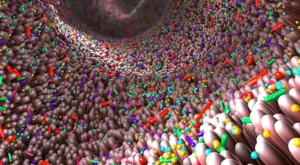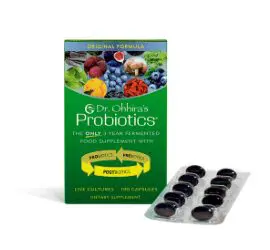Original Post Date:
December 12, 2016
Dr. Ohhira’s Probiotics originated from Dr. Ohhira’s Buddhist background and his reverence for nature. Over a period of ten years, Dr. Ohhira developed a multi-year fermentation process, which results in the production a wide range of postbiotic metabolites. Dr. Ohhira’s Probiotics is now widely recognized for its ability to transform, replenish, and maintain good health. It all begins with abundance of fresh herbs, fruits, mushrooms, seaweeds and vegetables, and, of course, pure water. A diversity of 13 strains of lactic acid bacteria are added to 80-gallon fermentation vats along with the foods to undergo a multi-year natural temperature fermentation process that produces a probiotic like no other because in contains and delivers over 500 postbiotic metabolites.
CREATING A HEALTHY MICROBIOME There are four main topics that are interrelated regarding how to create and maintain a healthy microbiome.
- DIVERSITY or Who Is Present? Diversity refers to the number of different species of bacteria a person carries in his/her intestinal tract. Studies show that indigenous cultures (people with little or no exposure to antibiotics, processed foods and environmental pollution) have 2x greater microbiome diversity compared to average Americans.1
- BALANCE – Balance refers to the relative number of each species of bacteria that are present in the GI tract. Taking high-dose (CFU) probiotics actually promotes an unbalanced microbiome. In a recent study, scientists stated the following; “Probiotics can be ineffective or even detrimental if not used at the optimal dosage for the appropriate purposes.”2
- PREBIOTICS – You MUST feed your probiotic bacteria well. There are two types of food/nutrients that probiotic bacteria require, which are dietary fiber and polyphenols. These compounds occur primarily in fruits and vegetables. Humans do not possess the genes that are required to digest dietary fibers. Also, many polyphenols are large molecules that are difficult for humans to absorb. Consequently, these compounds pass through the intestinal tract unchanged, but when they reach the large intestine/colon, they are the perfect food supply for your probiotic bacteria.
- POSTBIOTICS – This refers to the METABOLITES that your probiotic bacteria produce. Remember, probiotic bacteria are little “manufacturing plants.” The reason probiotic bacteria are important is totally related to the metabolites they produce and how those metabolites influence and regulate a wide range of biological functions in your body. In his recent book titled “The Mind-Gut Connection”, Emeran Mayer, M.D. states that, “your probiotic bacteria, with the information stored in their millions of genes, are able to produce hundreds of thousands of post-biotic metabolites.”3
Dr. Ohhira’s multi-year fermentation process optimizes these four requirements, which allows the starter strains of bacteria to create over 500 postbiotic metabolites. This explains why Dr. Ohhira’s fermentation process enables Dr. Ohhira’s Probiotics to deliver a much broader range of health benefits than other commercial probiotics.
A MULTI-YEAR FERMENTATION PROCESS Fermentation is a process in which bacteria (or other microorganisms) cause the chemical breakdown of substances into useable end products. In the human digestive tract, bacteria ferment or digest food, producing post-biotic metabolites.
Dr. Ohhira’s fermentation process mimics the fermentation processes that take place in the human digestive tract. The process begins by utilizing thirteen unique strains of probiotic bacteria. Then, at seasonally appropriate times throughout the year, various kinds of whole food plant crops are added to the fermentation vats as the nutritious prebiotic food supply for the probiotic bacteria.
Dietary plant carbohydrates (fibers) and polyphenols are the preferred foods for your probiotic bacteria. A wider range of dietary compounds supports the growth and proliferation of a wider range of probiotic bacteria. This promotes probiotic diversity.
POST-BIOTIC METABOLITES: This is real secret to the success of Dr. Ohhira’s Probiotics. When Dr. Ohhira’s Probiotics are encapsulated after 3 years of fermentation, each capsule contains some of the probiotic bacteria that were used in the fermentation process along with some of the remaining prebiotics. However, the vast majority of the final product is the postbiotic metabolites that were created during 3 years of fermentation.
More on the postbiotic metabolites: These postbiotic metabolites include vitamins, amino acids, short-chain fatty acids (SCFAs), immune system-enhancing compounds, detoxifying agents, cell signaling compounds, and probably many other beneficial substances that have not yet been fully researched. This is the Dr. Ohhira’s Advantage.
References:




